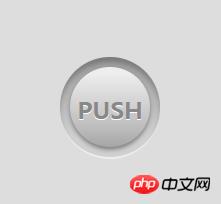Maison >interface Web >tutoriel CSS >Partager un code de style de bouton métallique
Partager un code de style de bouton métallique
- yuliaoriginal
- 2018-09-11 15:01:062398parcourir
Dans le projet, presque tous les sites Web utiliseront des boutons, allant d'une douzaine à quelques-uns. Un bouton pratique et esthétique peut ajouter beaucoup de couleur à la page, attirant ainsi l'attention de l'utilisateur. Lorsque je parcoure le site Web, je vois des boutons jolis et sympas. Prenez-les et partagez-les avec tout le monde. Si vous avez besoin de les utiliser la prochaine fois, copiez-les simplement.
Partie HTML :
<div id="button">
<a class="butt">PUSH</a>
</div>Partie CSS :
body {background: #ddd;}
#button {
width: 100px;
height: 100px;
border-bottom: 2px solid #eee;
background-image: -webkit-linear-gradient(top, #999, #d0d0d0 80% );
background-image: -moz-linear-gradient(top, #999, #d0d0d0 80% );
background-image: -ms-linear-gradient(top, #999, #d0d0d0 80% );
background-image: -o-linear-gradient(top, #999, #d0d0d0 80% );
background-image: linear-gradient(top, #999, #d0d0d0 80% );
-moz-border-radius: 100px;
-webkit-border-radius: 100px;
border-radius: 100px;
box-shadow: inset rgba(0,0,0,0.2) 0px 5px 6px ;
left: 50%;
top: 50%;
margin-left: -50px;
margin-top: -50px;
position: absolute;
}
.butt {
position: absolute;
width: 80px;
height: 52px;
left: 10px;
top: 10px;
cursor: pointer;
font-family: "Lucida Sans";
font-weight: bold;
font-size: 23px;
color: #888;
text-shadow: 0px 1px 0px #fff;
text-align: center;
padding-top: 28px;
-moz-border-radius: 100px;
-webkit-border-radius: 100px;
border-radius: 100px;
background-image: -webkit-linear-gradient(top, #eee, #bbb 70%, #9f9f9f 100% );
background-image: -moz-linear-gradient(top, #eee, #bbb 70%, #9f9f9f 100% );
background-image: -ms-linear-gradient(top, #eee, #bbb 70%, #9f9f9f 100% );
background-image: -o-linear-gradient(top, #eee, #bbb 70%, #9f9f9f 100% );
background-image: linear-gradient(top, #eee, #bbb 70%, #9f9f9f 100% );
background-position: 0 6px;
background-color: #eee;
background-repeat: no-repeat;
-webkit-box-shadow: rgba(0,0,0,.4) 0 3px 6px;
-moz-box-shadow: rgba(0,0,0,.4) 0 3px 6px;
box-shadow: rgba(0,0,0,.4) 0 3px 6px;
-webkit-transition: all .1s ease-in;
-moz-transition: all .1s ease-in;
-ms-transition: all .1s ease-in;
-o-transition: all .1s ease-in;
transition: all .1s ease-in;
}
.butt:hover {
background-position: 0 0px;
-webkit-box-shadow: rgba(0,0,0,.4) 0 3px 8px;
-moz-box-shadow: rgba(0,0,0,.4) 0 3px 8px;
box-shadow: rgba(0,0,0,.4) 0 3px 8px;
}
.butt:active {
width: 76px;
height: 48px;
margin: 2px 0 0 2px;
border-bottom: 1px solid #fff;
font-size: 21px;
color: #777;
-webkit-box-shadow: inset rgba(0,0,0,.5) 0px 5px 10px;
-moz-box-shadow: inset rgba(0,0,0,.5) 0px 5px 10px;
box-shadow: inset rgba(0,0,0,.5) 0px 5px 10px;
}Rendu :

Partagé ci-dessus I a créé un code de bouton très métallique. Pour des effets plus sympas, suivez-moi !
Ce qui précède est le contenu détaillé de. pour plus d'informations, suivez d'autres articles connexes sur le site Web de PHP en chinois!

